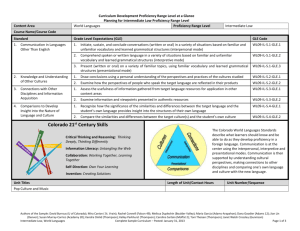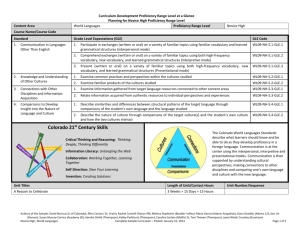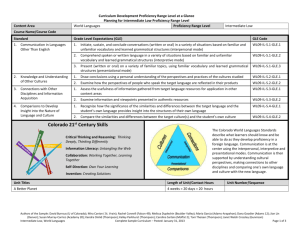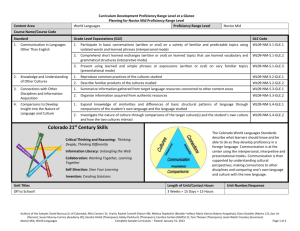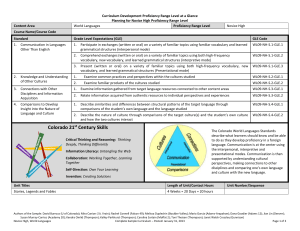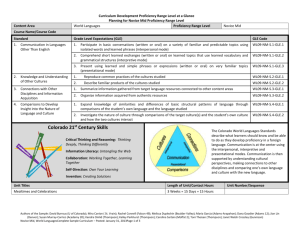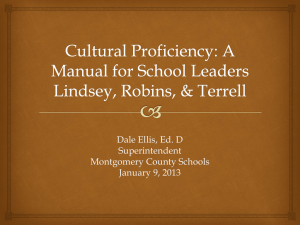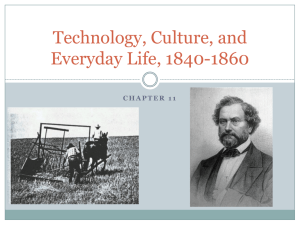Word
advertisement
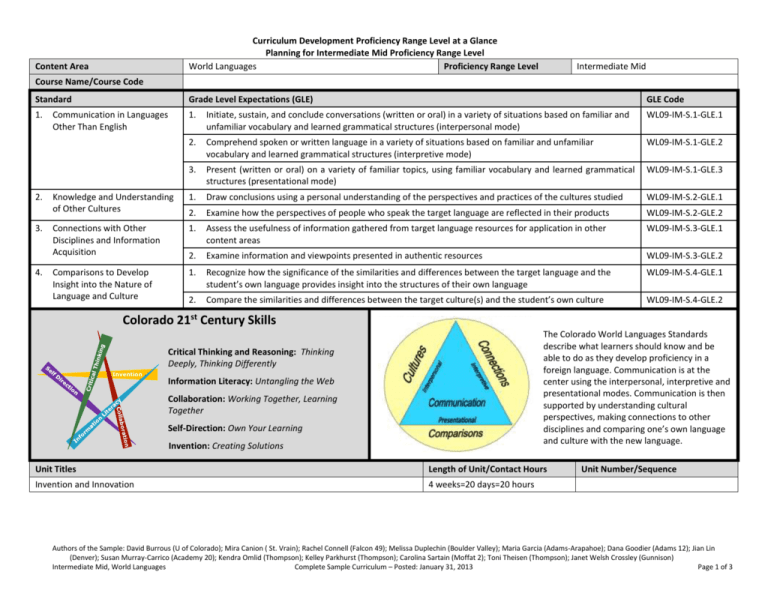
Curriculum Development Proficiency Range Level at a Glance Planning for Intermediate Mid Proficiency Range Level World Languages Proficiency Range Level Content Area Intermediate Mid Course Name/Course Code Standard Grade Level Expectations (GLE) GLE Code 1. 1. Initiate, sustain, and conclude conversations (written or oral) in a variety of situations based on familiar and unfamiliar vocabulary and learned grammatical structures (interpersonal mode) WL09-IM-S.1-GLE.1 2. Comprehend spoken or written language in a variety of situations based on familiar and unfamiliar vocabulary and learned grammatical structures (interpretive mode) WL09-IM-S.1-GLE.2 3. Present (written or oral) on a variety of familiar topics, using familiar vocabulary and learned grammatical structures (presentational mode) WL09-IM-S.1-GLE.3 Knowledge and Understanding of Other Cultures 1. Draw conclusions using a personal understanding of the perspectives and practices of the cultures studied WL09-IM-S.2-GLE.1 2. Examine how the perspectives of people who speak the target language are reflected in their products WL09-IM-S.2-GLE.2 Connections with Other Disciplines and Information Acquisition 1. Assess the usefulness of information gathered from target language resources for application in other content areas WL09-IM-S.3-GLE.1 2. Examine information and viewpoints presented in authentic resources WL09-IM-S.3-GLE.2 Comparisons to Develop Insight into the Nature of Language and Culture 1. Recognize how the significance of the similarities and differences between the target language and the student’s own language provides insight into the structures of their own language WL09-IM-S.4-GLE.1 2. Compare the similarities and differences between the target culture(s) and the student’s own culture WL09-IM-S.4-GLE.2 2. 3. 4. Communication in Languages Other Than English Colorado 21st Century Skills The Colorado World Languages Standards describe what learners should know and be able to do as they develop proficiency in a foreign language. Communication is at the center using the interpersonal, interpretive and presentational modes. Communication is then supported by understanding cultural perspectives, making connections to other disciplines and comparing one’s own language and culture with the new language. Critical Thinking and Reasoning: Thinking Deeply, Thinking Differently Invention Information Literacy: Untangling the Web Collaboration: Working Together, Learning Together Self-Direction: Own Your Learning Invention: Creating Solutions Unit Titles Length of Unit/Contact Hours Invention and Innovation 4 weeks=20 days=20 hours Unit Number/Sequence Authors of the Sample: David Burrous (U of Colorado); Mira Canion ( St. Vrain); Rachel Connell (Falcon 49); Melissa Duplechin (Boulder Valley); Maria Garcia (Adams-Arapahoe); Dana Goodier (Adams 12); Jian Lin (Denver); Susan Murray-Carrico (Academy 20); Kendra Omlid (Thompson); Kelley Parkhurst (Thompson); Carolina Sartain (Moffat 2); Toni Theisen (Thompson); Janet Welsh Crossley (Gunnison) Intermediate Mid, World Languages Complete Sample Curriculum – Posted: January 31, 2013 Page 1 of 3 Curriculum Development Overview Unit Planning for Intermediate Mid Proficiency Range Level in World Languages Unit Title Invention and Innovation Focusing Lens(es) Values Inquiry Questions (Engaging- Debatable): Unit Strands 1. Communication in Languages Other Than English 3. Connections with Other Disciplines and Information Acquisition Foundational Concepts in World Languages Interpersonal Communication, Interpretive Communication, Presentational Communication, Cultures, Connections, Comparisons Concepts Innovation, Invention, Creativity, Contemporary Life Length of Unit Standards and Grade Level Expectations Addressed in this Unit 4 weeks=20 days=20 hours WL09-IM-S.1-GLE.1; WL09-IM-S.1-GLE.2; WL09-IM-S.1-GLE.3; WL09-IM-S.2-GLE.1; WL09-IM-S.2-GLE.2; WL09-IM-S.3-GLE.1; WL09-IM-S.3-GLE.2; WL09-IM-S.4-GLE.1; WL09-IM-S.4-GLE.2 How are invention and innovation creative ways to solve real world problems? 2. Knowledge and Understanding of Other Cultures 4. Comparisons to Develop Insight into the Nature of Language and Culture Generalizations My students will Understand that… Guiding Questions Factual Conceptual Knowledge of inventions and innovations from the target cultures provides insight into the culture’s values and increases appreciation of the target cultures’ contribution globally. What values are reflected by inventions? How are cultural values present in cultural products? WL09-IM-S.2-GLE.2-IQ.3 Creativity positively impacts science and technology, resulting in innovations and inventions that help solve inter and intra national problems. What inventions and innovations have been developed in the target cultures? How does creativity affect problem solving in daily life? Solutions to complex (and global) problems require the perspectives and participation of individuals across diverse nations/cultures. What problems do innovations in science and technology address? How does innovation shape society? Authors of the Sample: David Burrous (U of Colorado); Mira Canion ( St. Vrain); Rachel Connell (Falcon 49); Melissa Duplechin (Boulder Valley); Maria Garcia (Adams-Arapahoe); Dana Goodier (Adams 12); Jian Lin (Denver); Susan Murray-Carrico (Academy 20); Kendra Omlid (Thompson); Kelley Parkhurst (Thompson); Carolina Sartain (Moffat 2); Toni Theisen (Thompson); Janet Welsh Crossley (Gunnison) Intermediate Mid, World Languages Complete Sample Curriculum – Posted: January 31, 2013 Page 2 of 3 Curriculum Development Overview Unit Planning for Intermediate Mid Proficiency Range Level in World Languages Critical Content: Key Skills: My students will Know… My students will be able to (Do)… Culture: Significant inventions and innovations from target cultures Context: Professions Technical terms Inventions Problem Solving Dates Adjectives Past tenses Future tense Conditional Subjunctive If, then clauses STEM Social Studies Business Structure: Connections to: Within the context of this unit, students will be able to demonstrate in the target language the three modes of communication – interpersonal, interpretive and presentational. Some examples can include, but may not be limited to: Research scientific and technological inventions Identify and discuss scientific discoveries and inventions of the target cultures; Understand the significance of these innovations in our lives and the lives of others Discuss the value of inventions and innovations from the target culture Create an invention that improves contemporary life (WL09-IM-S.1-GLE.1) and (WL09-IM-S.1-GLE.2) and (WL09-IM-S.1-GLE.3) Critical Language: includes the Academic and Technical vocabulary, semantics, and discourse which are particular to and necessary for accessing a given discipline. Academic Vocabulary: Act, analyze, clarify, compare, contrast, create, describe, design, discuss, evaluate, invent, innovation, imagine, reflect, summarize Technical Vocabulary: interpersonal, interpretive, presentational, grammatical terms, practices, products, perspectives, connections, performance, proficiency range Authors of the Sample: David Burrous (U of Colorado); Mira Canion ( St. Vrain); Rachel Connell (Falcon 49); Melissa Duplechin (Boulder Valley); Maria Garcia (Adams-Arapahoe); Dana Goodier (Adams 12); Jian Lin (Denver); Susan Murray-Carrico (Academy 20); Kendra Omlid (Thompson); Kelley Parkhurst (Thompson); Carolina Sartain (Moffat 2); Toni Theisen (Thompson); Janet Welsh Crossley (Gunnison) Intermediate Mid, World Languages Complete Sample Curriculum – Posted: January 31, 2013 Page 3 of 3
